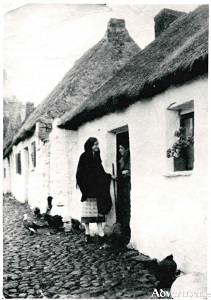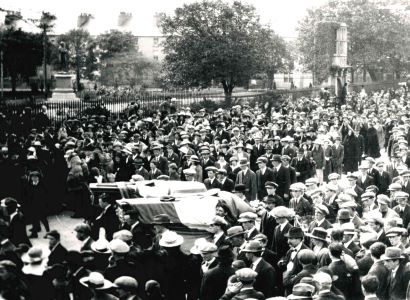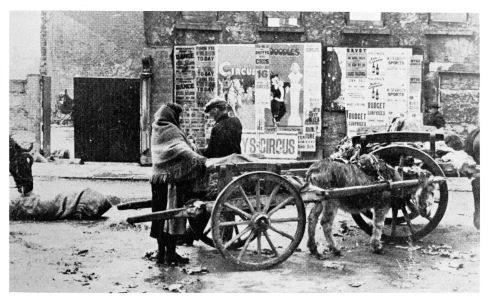Old Galway
Wolfe Tones, County Football Champions, 1936

by Tom Kenny
Now that GAA club games are being played again, we thought to show you the County Champions of 1936, Wolfe Tones. They were a city based team who also won the championship in 1941 but after that they seemed to fade out.
Fairies and pookas in The Claddagh

by Tom Kenny
These two women are chatting at the doorway of a Claddagh house on Dogfish Lane c1920. The lane is cobbled, the geese and hens are pecking around, the thatch roof is perfect, there are flowers on the windowsill, everything is calm and peaceful, but what are they talking about? Could it be about piseógs, about the ‘good people’, the fairies, the banshee?
A VIOLENT NIGHT IN GALWAY

by Tom Kenny
Edward Krumm was 5’ 11”, 26 years old, a bachelor and a member of the Church of England from Middlesex. He was a lorry driver with the Black and Tans and had been in Galway three weeks when he arranged to meet a civilian driver he had come to know in a pub in Abbeygate Street. This man, Christopher Yorke, described Krumm as a “generally reckless fellow who drank a lot”. Krumm was fairly drunk brandishing a revolver and bragging that he could knock the neck off a bottle at ten yards range, and apparently shot at a few bottles in the pub.
THE BEST YEARS OF OUR LIVES

by Tom Kenny
It is that time of the year again when children go back to school. It will be different this year as most of them will be delighted to return to classes the meet their friends after such a long break. For older generations, this time of year was, in the words of the Bard, more akin to ‘creeping like snail unwillingly to school”. And yet, when we look back on our schooldays, it is usually with affection. The old cliché ‘the best years of our lives’ still applies. It was where were educated, matured, learned and developed skills, remembered quotations like the above from the Bard, made friends for life.
BUTTERMILK LANE

by Tom Kenny
William Evans was a distinguished painter in the nineteenth century who did a very unusual and adventurous thing for an English artist at the time, he travelled widely in Conamara and West Mayo. We can only speculate what attracted him to this wild, rugged and remote terrain but he liked the parts of the country least visited, and said that “Ireland failed to attract the pencils of the recording brethren of the easel and lay like a virgin soil untouched by the plough”. He produced many studies and finished watercolours, a mixture of landscapes, streetscapes and market scenes and what might be called peasant structures and peasant portraits.
THE LOCAL SECURITY FORCE

by Tom Kenny
In the first years of the Second World War, the numbers of personnel in the army multiplied by between six and seven times. The Army began by calling up on permanent service part-time soldiers already in existence, ie, reserve and volunteer units. By early summer 1940, numbers had to double again. These new recruits had to be trained and this put a major strain on army resources.
SHOP STREET, 1903

by Tom Kenny
This was Shop Street, Galway’s main street, decorated for the visit of Edward VII in 1903. The poles along the footpath were especially erected to carry bunting and decorations and many buildings had their own flags and other forms of decoration. It was a big occasion in the city. The prince came into the station on the railway from Clifden, was taken by horse and carriage around the Square, through the streets and around by Raven Terrace and back to the Docks where his royal yacht was waiting.
GOING TO MARKET

by Tom Kenny
“Every Saturday morning a procession of donkey-carts set out, nose to tail, for the market in Galway. This took place in the triangular patch by the Collegiate Church of St. Nicholas. It dates from 1320 and was dedicated to St. Nicholas, the patron saint of sailors, who was chosen then as the patron saint of Galway. There the donkeys were unharnessed and tethered to a wheel, the shafts were let down to the ground and the goods to be sold were displayed on the sloping cart. Vendors came from many more prosperous areas and their wares were a source of envy to those who lived in the congested strip along the coast. Eggs in big wicker baskets with hinged lids, ducks, hens and chickens, wooden kegs of buttermilk, home churned butter laid in rolls on cabbage-leaves, cabbages, onions, sometimes geese, hand-knitted socks – all sold briskly throughout the morning to the people of the town.
.png)